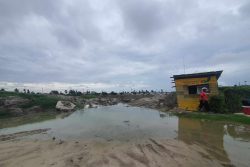DERNA, Libya (Reuters) – People whose homes were swept away by flooding in Libya’s eastern city of Derna a week ago faced the dilemma on Sunday of whether to stay and risk infection or flee through areas where landmines have been displaced by the torrents.
Thousands of people were killed after two dams above Derna broke on Sept. 10 during a powerful storm, bringing down residential blocks lining a usually dry riverbed as people slept. Many bodies have been washed out to sea.
The United Nations Office for the Coordination of Humanitarian Affairs (OCHA) on Saturday cited a death toll of 11,300 from the Libyan Red Crescent. However, a spokesman for the Libyan Red Crescent appeared to cast doubt on that, saying “figures are changing and the Red Crescent is not responsible for this.”
OCHA spokesperson Eri Kaneko said it was difficult to get exact casualty figures as the search for bodies and survivors continues, and said the World Health Organization (WHO) had so far confirmed 3,922 deaths. The health minister for the Libyan eastern government on Sunday said 3,283 had died.
More than 1,000 have already been buried in mass graves, according to the United Nations, and aid groups have warned against the practice. Libyan authorities have confirmed that 150 people have been poisoned by polluted water in the flood-hit areas.
Mohamed Wanis Tajouri said he had come to Derna from Benghazi down the coast with fellow medical students to carry out disinfection and sterilization work. “After floods epidemics occur,” he said.
Sunrise on Sunday revealed a scene of quiet devastation, with piles of rubble cleared to the sides of empty roads along with tangled metal including pieces of wrecked cars.
Hamad Awad sat on a blanket on an empty street with a bottle of water and bedding alongside him.
“I am staying in our area trying to clean it and trying to verify who is missing,” he said. “Thank God for giving us patience.”
Entire districts of Derna, with an estimated population of at least 120,000, were swept away or buried in mud. State media said at least 891 buildings had been destroyed in the city, whose mayor has said 20,000 people may have died.
Mohamed Alnaji Bushertila, a government employee, said 48 members of his wider family were missing. Another resident said survivors were at a loss over what to do next.
“We still do not know anything, we are hearing rumours, some are trying to reassure us, others are saying you need to leave the city or stay here,” said the man, who gave just one name, Wasfi. “We have no water and no resources.”
The homeless are surviving in makeshift shelters, schools or packed into the houses of relatives or friends, OCHA said.
The flooding affected machinery on the lower level of the hospital, the hospital’s head, Abdel Rahim Mazek, said.
Elsewhere in the town, volunteers handed out clothing and food.
Volunteer Abdulnabi said the team came from Ajaylat, around 800 miles (1,200 km) away in western Libya, divided from the east by more than a decade of on and off conflict.
The country of 7 million people has lacked a strong central government since a NATO-backed uprising that toppled Muammar Gaddafi in 2011 and its oil wealth is dispersed among competing groups.
Analysts said the disaster had brought some coordination between the internationally-backed administration in Tripoli in the west and the rival administration in the east but that reconstruction efforts would likely reopen fault-lines.







